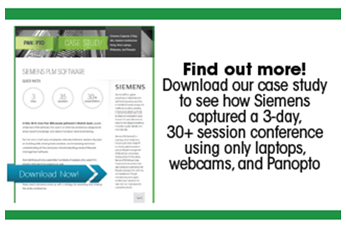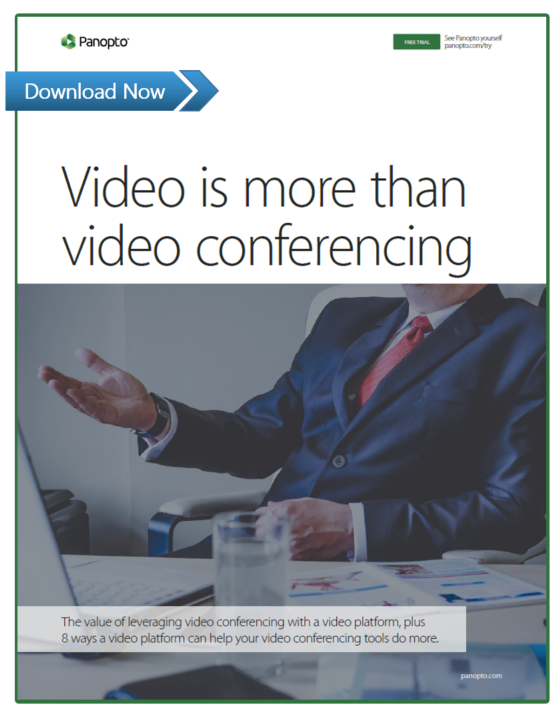- Communications
3 Ways A Video Platform Can Improve How You Record Events, Meetings, And More
Given the relative ubiquity of video conferencing solutions in the office today, it’s no surprise that, for many organizations, the first few use cases for video in the enterprise focus on communications.
Yet as video grows in your organization, and as video becomes ever more pervasive in the world around us, new and unique use cases that solve organizational challenges and create competitive differentiation will continue to arise — and those use cases will demand video support that runs the gamut from simple communications to remote location multi-stream recording in HD.
As Gartner Research notes, “Workers are discovering use cases for sharing social video, often delivered via an ‘enterprise YouTube’. Enterprise architects, training managers, corporate communications and public affairs officers can aggregate the best of these, suggest more, and launch broad projects to support them.”
An enterprise video platform allows you to capture content in a wide variety of ways — supporting your existing video conferencing solution and enabling a range of other scenarios, including:
1 | Meeting capture with multimedia integration
Web- and video-conferencing tools open the door to interactive live video communication. But these tools, in their core functionality and their workflows, were not built to record video and presentations. WebEx and Adobe Connect, for example, each capture only audio without video, plus output from a single screen.
A video platform, however, is not limited to those functions and can allow you to capture:
- Multiple video streams, even from multiple locations
- The contents of single or multiple PC screens
- Presentation slides from PowerPoint or Keynote
- As well as every word spoken and every word that appears in the video recording, for search purposes
With a modern video platform, you can record every detail of your meetings in HD – every slide, every whiteboard diagram, and every webcam video feed. Equally important, it integrates with a central video library, making the recordings immediately available for editing, viewing and sharing on all major desktop, laptop and mobile operating systems.
Paired with a video conferencing tool, a video platform helps you record, share, and scale your presentations, pitches, meetings and more.
See what a recorded meeting looks like in Panopto in the video below:
Related reading: 5 Times to Ditch Video Conferencing – and 1 Time You Need It
2 | Corporate event videos that give remote viewers a “next best thing” experience
Corporate events and conferences serve several vital purposes. They offer a venue for the organization to present relevant information at scale, and for employees, partners, and customers to meet and share ideas as they learn about updates from the organization.

Organizational events, however, must contend with two significant challenges:
- First, there are always those who can’t attend the event in person, which creates a challenge for how best to disseminate the information on-demand.
- Second, event AV coordination is time-consuming, expensive and often difficult to manage.
Web conferencing tools aren’t built for live streaming or recording those live on-stage events. Technical limitations like audience size maximums, restrictions on the total number of video inputs, compatibility issues with cameras other than webcams, and other issues mean these tools simply aren’t able to support even relatively simple conferences or events.
Here too, a video platform can be a solution, providing the ability to easily record and share special events, as well as to live webcast video of your conference to thousands of virtual attendees around the world.
Many organizations have already proven there’s no event too big to capture and share with video. Siemens, for example, recorded a 3-day, 30+ session international conference — using only laptops, webcams, and its video platform.
Gartner agrees, and even offers a list of potential events organizations can supplement or replace with video:
- Customer appreciation events;
- Employee and volunteer appreciation events;
- Internal knowledge sharing and training conferences;
- Industry gatherings;
- Charity events;
- Compelling, interactive demonstrations of innovative products and services;
- Plant or campus tours for remote “visitors”; and more.
3 | Centrally manage an entire library of video content
Web conferencing solutions are built to enable real-time video communications, but they don’t provide content management features that help your organization drive real value from video after the live interaction wraps up.
A video platform supplements those tools to provide a means to not only capture video, but to centrally store, search, edit, share, view, and analyze that video content from any video source, on-demand.
A video platform can even help you make better use of the video you capture from your web conferencing tools. Many organizations already use the built-in recording capabilities in GoToMeeting, Zoom, or Bluejeans and have developed enormous libraries filled with those recorded conversations. A video platform can make managing all those videos easier, by programmatically ingesting the recordings into a centralized, searchable “YouTube for Business” using a simple API.
Learn how a video content management system (video cms) works:
While every video platform is unique, you can expect a modern solution to bring you:
- A single, central repository for all videos, wherever and however that video was created
- Integrated recording tools to capture and live webcast new videos
- Intelligent video search; both across your library and inside the content of each recording
- Device-agnostic video viewing, enabling anyone to play any video on any device
- Support for multiple file types, enabling content creators to import any type of video to be uploaded and transcoded for playback
- A highly functional, easy to use video editor that’s browser-based and available on any laptop
- Enterprise-ready access control; including identity management connections and options to deploy onsite behind your firewall or securely in the cloud
As Forrester Research notes, “As a general principle, if it’s worth saving it’s worth finding.” This broad spectrum of video content management capabilities is what makes a video platform such a valuable part of your overall investment in video.

Learn more about how a video platform can support your video conferencing tools.
In our latest white paper, Video Is More Than Video Conferencing, we’ll explore more about how organizations can leverage a video platform to make the most of their investments in video — and spotlight valuable ways that businesses can use video conferencing and video platform tools together to drive real bottom line returns.


